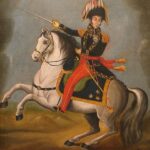![]()
In 1917 Shelton Brooks erupted with The Darktown Strutters Ball. When I first heard the Six Brown Brothers’ (six saxophones) record of this song many years ago, I knew I was listening to something special.
Even though by 1917 writers were catching on to the fact that there was more to the American popular music potential than they had ever dreamed, this song stood out far above the average pop song of the period. And particularly unusual for those or any days, it had a very good, driving verse.
There’s something so free and easy, so insouciant, about a chorus which dares to start out with Mr. Brooks’s line ‘T il be down to get you in a taxi, honey.” And the melody has the same flexible, pliant, yet swinging air about it. Illustrations of a song as deeply imbedded in the American ear as this is needn’t even be offered.
But I think it wise to try to erase all memory of it, and then before memory insidiously gets a chance to reassert itself, go over the tune with complete detachment. If you can manage such a miracle, you’ll find that this is a simply dandy tune. I’d forgotten until I re-examined it that toward the end of the chorus it has two marvelous “break” moments in two successive phrases: first where it says “goin’ to dance out both my shoes” and then “when they play the ‘Jelly Roll Blues”. It’s as if the rest in the music following those phrases were meant for a tap dancer or an instrumental “ riff.” And probably they were.
The song has been recorded many times and is considered a popular and jazz standard. There are many variations of the title, including “At the Darktown Strutters’ Ball”, “The Darktown Strutters’ Ball”, and just “Strutters’ Ball”, etc. Check Wikipedia for this song for more info.







